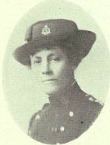Name Margaret MacDonald | ||
 | ||
Born 1873 Bailey Brook, Nova Scotia Died 1948, Bailey Brook, Nova Scotia, Canada | ||
Major Margaret Clothilde MacDonald (1873 in Bailey Brook, Nova Scotia, Canada – 1948 in Bailey's Brook, Nova Scotia, Canada) was a Canadian nurse. On 4 November, 1914, she was appointed Matron-in-Chief of the Canadian Army Medical Corps Nursing Service overseas, becoming the first woman in the British Empire to hold the relative rank of major during a nursing career of over thirty years. A member of the permanent force, previously she had served in the Spanish–American War and was one of twelve Canadian women who served in the Second Boer War. She was awarded the Royal Red Cross and the Florence Nightingale Medal.
She graduated as a nurse from the New York City Hospital in 1895. After achieving her post-graduate, she went to Panama to serve for eighteen months during the building of the Panama Canal. There, she caught malaria and promptly returned after she recovered. In the Spanish–American War she served at Camp Wikoff. Camp Wikoff was used to quarantine 29,000 soldiers, including Theodore Roosevelt and the Rough Riders at the conclusion of the Spanish–American War, to prevent the spread of yellow fever and other tropical diseases.
In 1901, nurses officially became a component of the Canadian Army Medical Service (later the Canadian Army Medical Corps, later still, the Royal Canadian Army Medical Corps), with nursing sisters Georgina Pope and Macdonald being appointed as the first full-time Canadian military nurses in 1906. Over 3,000 nursing sisters served in World War I.
MacDonald was one of five founding members of the C.A.M.C.'s nursing service and the second to serve as the Matron-in-Chief.
Her work also brought her to Quebec City, Kingston, Ontario, Halifax, Nova Scotia, as well as England. While working in London, she was responsible for over 1,900 Canadian nurses. She returned to Canada in the Fall of 1919 to help in the re-organization of the Royal Canadian Army Medical Corps. She retired in 1923 at the age of 51.
After her military career, she travelled extensively. She earned an honorary DDL from St. Francis Xavier University. A ceremony took place in 1926 at Parliament Hill to unveil a memorial to the Canadian Nursing Sisters, a sculpted marble panel which portrays the history of Canadian nurses. She was immortalized as a national historic person of Canada by a plaque set in her birthplace in 1983.
